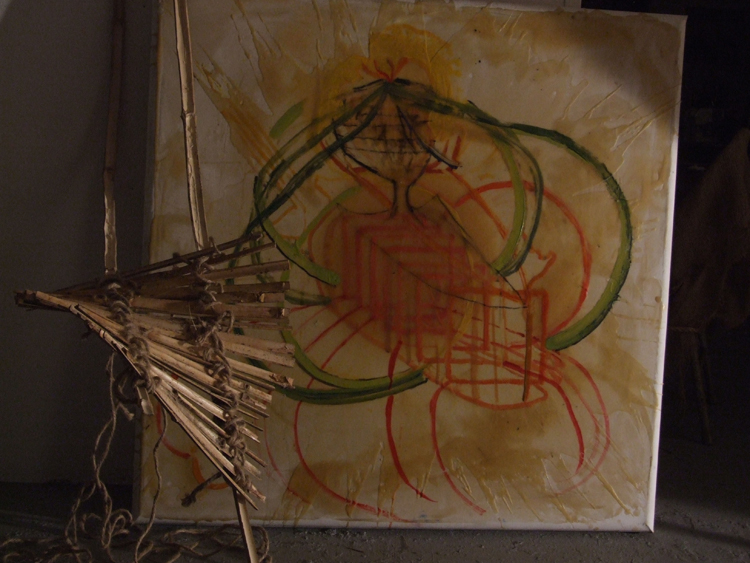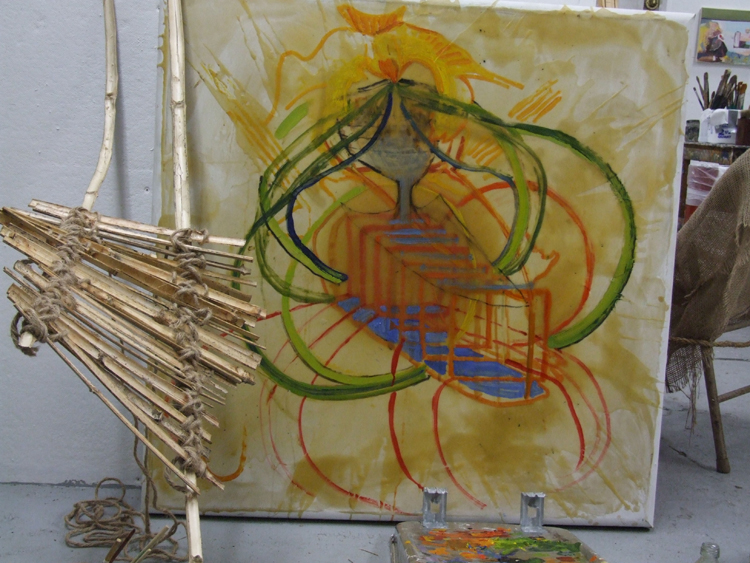Panoptigarden: A tale of fourcity Panoptigarden was first a vast, lush tangled garden. As the first people settled on its slightly sloped grounds, they drew wide circles in the ground with their hands. The circles went up the hill but the hill never reached an apex. It began to rain and flow water in these drawn swales, and as more and more water built up, the slope of the ground tipped down towards the horizon so that the only indication of the ascent of the land is now the circular movement of Panoptiguarden’s channels of waters.
Inside its watery walls are large vessels made of clay at the base of the rising land. The channels are drawn into it through large breathing clay roots which are coated with lichens. These algeafungae clean the passing waters and every morning give off a golden bit of bread that the people of the city go to and scrape off with large awls. Then they gather it in great wooden bottles and eat it all day as uncooked bread.
Uphill (which is actually just forward) from the clay vessels beyond a porous wall of kudzu and bamboo is a crucible of copper plates which reflect the faces and unspoken word forms of the people of the city. The plates are cast in great ribs that look like those of the beasts they imagine in the oceans that they have never seen. The grass-wood ribs are coated with mud brick clay, straw and sand mixed with rice which allows them to host fine threads of metal that pass through the rib’s slats. On the other end of these metal threads are the plants and trees of the city next to which the people of Panopticon put devotional crucibles of clay, iron and copper. These devotions are like tuning forks for the trees and plants, so together they send in the charges that they pick up from the latent rumors harbored in the minds of the people. As the charges pass into the copper plates, their forms are seen as elongated faces and masks of great appeal and bitter draught. The plates in turn charges the water that surrounds them, causing a great mist to rise forward on the slope into great baskets of cane and retan that bulge with their inflation. At the top of the slope they are burnt in great winged ark pilots curved like ox-horns against the sky. From this fine fire ignition, the city runs its many engines. As they run they sweat water back into the great channels that were first mere lines drawn in the ground by the first people of Panoptigarden
Panoptigarden (called Panoptiguarden when spoken about in terms relative to its surroundings) is sometimes approached by three surrounding hills, each with a salient city perched upon is pinnacle. To the west is Medaigogi which is comprised of just one tower with five large roofs stacked below and nine ribs rising into the sky above. At the top of the ribs is a large bell that sounds and draws the eyes of the people of Panoptiguarden every hour: When seen from the east the tower warps the sun rays into a eye-shaped lozenge and casts light in triangle from its southern tip to the low and high north. At election time, pops and cracks can be heart from the surrounding spruce forests: one out of seven canidates wins by squinting his eyes, walking into the forest with a rifle and waiting for movement to ripple the waters of his blurred vision. The first politician to shoot a straying rabbit amongst the cedars wins the election of Medaigogi. As the shots are fired, the plants and trees of Panoptiguarden wince and send heavy charges into copper plates in the water so that the machines run stronger and give off more water than usual that day.
To the south and the north are the cities of Melasurej and Rexile..........


